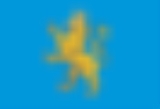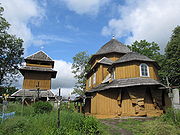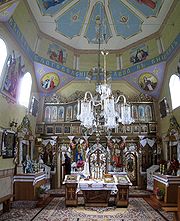
Sielec, Drohobych Raion
Encyclopedia



Sambir
Sambir is a city in the Lviv Oblast, Ukraine. Serving as the administrative center of the Sambir Raion , the city itself is also designated as a separate raion within the oblast. It is located at around , close to the border with Poland.-History:...
within Drohobych district of Lviv province
Lviv Oblast
Lviv Oblast is an oblast in western Ukraine. The administrative center of the oblast is the city of Lviv.-History:The oblast was created as part of the Ukrainian Soviet Socialist Republic on December 4, 1939...
in western Ukraine
Ukraine
Ukraine is a country in Eastern Europe. It has an area of 603,628 km², making it the second largest contiguous country on the European continent, after Russia...
. The village was founded probably in the 15th century CE.
To the north lies the village and forest of Szade (Сіде), to the east Horodyshche (Городище), to the south Mokriany
Mokriany
Mokriany , is a village in Lviv Oblast, Drohobych Raion, Ukraine. Zip code is 82125. It was founded in 1515 and currently has a population of 383.-External links:...
(Мокряни) and to the west Vilshanyk (Вільшаник). Geographically, the area lies in the Dniester
Dniester
The Dniester is a river in Eastern Europe. It runs through Ukraine and Moldova and separates most of Moldova's territory from the breakaway de facto state of Transnistria.-Names:...
river basin, to which the Bystrytsia
Bystrytsia River
The Bystrytsia is a river, a right tributary of the Dniester which flows through Ukraine. The upper half of the Bystrytsia river is divided into two parts: Bystrytsia-Solotvynska and Bystrytsia-Nadvirnyanska...
(Бистриця) and Cherkhavka (Черхавка) rivers are tributaries.
Together with the villages of Kotovane (Котоване) and Stupnytsia (Ступниця), it administratively forms a local village council.
History
The village was first mentioned in 1538 in a document from 1559. King Michał Korybut Wiśniowiecki established the parish between 1669 and 1673, during which time a royal church was constructed. Another church with its own parish for the local Polish-speaking nobility (szlachta) was built later; both parishes coexisted before they later merged.While the area was crown property, the Dżurdż family was given half of it at an unknown date. Around 1650 King John II Casimir awarded the Cossack
Cossack
Cossacks are a group of predominantly East Slavic people who originally were members of democratic, semi-military communities in what is today Ukraine and Southern Russia inhabiting sparsely populated areas and islands in the lower Dnieper and Don basins and who played an important role in the...
Ataman
Ataman
Ataman was a commander title of the Ukrainian People's Army, Cossack, and haidamak leaders, who were in essence the Cossacks...
Skrebeciowicz the other half of the Sielec estate, as well as the right to bear the Sas coat of arms for his loyal services to the crown during the Khmelnytsky Uprising
Khmelnytsky Uprising
The Khmelnytsky Uprising, was a Cossack rebellion in the Ukraine between the years 1648–1657 which turned into a Ukrainian war of liberation from Poland...
. After the Austrian partition
Austrian partition
The Austrian partition refers to the former territories of the Polish-Lithuanian Commonwealth acquired by the Austrian Empire during the partitions of Poland in late 18th century.-History:...
of southern Poland in 1772, the Skrebeciowicz de Sielecki family
Sielecki family
Sielecki is a Polish surname, also of one of the noble families. It is derived from the village of Sielec, of which many exist with that name in Poland, Ukraine and Belarus....
’s noble status was reaffirmed by the imperial court in Vienna
Vienna
Vienna is the capital and largest city of the Republic of Austria and one of the nine states of Austria. Vienna is Austria's primary city, with a population of about 1.723 million , and is by far the largest city in Austria, as well as its cultural, economic, and political centre...
who gave it the hereditary German title of Ritter
Ritter
Ritter is a designation used as a title of nobility in German-speaking areas. Traditionally it denotes the second lowest rank within the nobility, standing above "Edler" and below "Freiherr"...
.
According to historical documents, in 1880 Sielec had a total population of 781 inhabitants, of which 657 were Greek Catholics, thirty-two were Roman Catholics, eighty-five were Jewish, and seven were of other faiths. According to an 1889 census, 728 of the inhabitants at the time were ethnic Ukrainian
Ruthenians
The name Ruthenian |Rus']]) is a culturally loaded term and has different meanings according to the context in which it is used. Initially, it was the ethnonym used for the East Slavic peoples who lived in Rus'. Later it was used predominantly for Ukrainians...
(Rusyny), fifty were Polish
Poles
thumb|right|180px|The state flag of [[Poland]] as used by Polish government and diplomatic authoritiesThe Polish people, or Poles , are a nation indigenous to Poland. They are united by the Polish language, which belongs to the historical Lechitic subgroup of West Slavic languages of Central Europe...
, and three were German-speaking
German language
German is a West Germanic language, related to and classified alongside English and Dutch. With an estimated 90 – 98 million native speakers, German is one of the world's major languages and is the most widely-spoken first language in the European Union....
(Galiziendeutsche). Furthermore, the town incorporated 172 houses in the same census; the manor house
Manor house
A manor house is a country house that historically formed the administrative centre of a manor, the lowest unit of territorial organisation in the feudal system in Europe. The term is applied to country houses that belonged to the gentry and other grand stately homes...
(dwór) and local lords’ estates employed around forty-seven people.
The area changed hands multiple times: after the collapse of the Austro-Hungarian empire in 1918, Sielec reverted back to newly independent Poland
Second Polish Republic
The Second Polish Republic, Second Commonwealth of Poland or interwar Poland refers to Poland between the two world wars; a period in Polish history in which Poland was restored as an independent state. Officially known as the Republic of Poland or the Commonwealth of Poland , the Polish state was...
and administratively became a part of Lwów Voivodeship
Lwów Voivodeship
Lwów Voivodeship was an administrative unit of interwar Poland . According to Nazis and Soviets it ceased to exist in September 1939, following German and Soviet aggression on Poland . The Polish underground administration existed till August 1944.-Population:Its capital, biggest and most...
. In late September 1939, following German and Soviet aggression on Poland and Molotov-Ribbentrop Pact
Molotov-Ribbentrop Pact
The Molotov–Ribbentrop Pact, named after the Soviet foreign minister Vyacheslav Molotov and the German foreign minister Joachim von Ribbentrop, was an agreement officially titled the Treaty of Non-Aggression between Germany and the Soviet Union and signed in Moscow in the late hours of 23 August 1939...
, Lwów Voivodeship was divided by the two sides. Sielec was occupied by the Soviets and incorporated into Ukrainian Soviet Socialist Republic, only to be overrun again by the invading German Wehrmacht
Wehrmacht
The Wehrmacht – from , to defend and , the might/power) were the unified armed forces of Nazi Germany from 1935 to 1945. It consisted of the Heer , the Kriegsmarine and the Luftwaffe .-Origin and use of the term:...
in the summer of 1941. After the war it was finally incorporated into Ukraine. The population dropped substantially due to World War II
World War II
World War II, or the Second World War , was a global conflict lasting from 1939 to 1945, involving most of the world's nations—including all of the great powers—eventually forming two opposing military alliances: the Allies and the Axis...
and the Stalinist Soviet regime. The local Jewish population was murdered during the Holocaust, after the war members of the local nobility as well as wealthier peasants and non-Ukrainians were either executed or deported to Siberia by the communists, where they perished in the gulag
Gulag
The Gulag was the government agency that administered the main Soviet forced labor camp systems. While the camps housed a wide range of convicts, from petty criminals to political prisoners, large numbers were convicted by simplified procedures, such as NKVD troikas and other instruments of...
s. Farmers were forced to hand over their land for collectivization. After the fall of the Iron Curtain in 1989 and the collapse of the local kolkhoz
Kolkhoz
A kolkhoz , plural kolkhozy, was a form of collective farming in the Soviet Union that existed along with state farms . The word is a contraction of коллекти́вное хозя́йство, or "collective farm", while sovkhoz is a contraction of советское хозяйство...
, high unemployment forced many, especially young people, to leave for larger towns in flights of urbanization
Urbanization
Urbanization, urbanisation or urban drift is the physical growth of urban areas as a result of global change. The United Nations projected that half of the world's population would live in urban areas at the end of 2008....
. The 2001 national census counted 164 inhabitants, and in 2009 the village consisted of around 40 houses, down from 300 in the past.
Sights
The area is marked by rolling hills and agricultural land rich with chornozemChernozem
Chernozem , also known as "black land" or "black earth", is a black-coloured soil containing a high percentage of humus 7% to 15%, and high percentages of phosphoric acids, phosphorus and ammonia...
. The local economy consists mainly of farming, along with animal husbandry of cattle and horses. The manor house remains have been lost over time as well as the royal church mentioned in historical annals, while the church for the nobility still exists.
The Greek Catholic Church of the Theotokos
Theotokos
Theotokos is the Greek title of Mary, the mother of Jesus used especially in the Eastern Orthodox, Oriental Orthodox, and Eastern Catholic Churches. Its literal English translations include God-bearer and the one who gives birth to God. Less literal translations include Mother of God...
is located on a hill. With its belfry
Bell tower
A bell tower is a tower which contains one or more bells, or which is designed to hold bells, even if it has none. In the European tradition, such a tower most commonly serves as part of a church and contains church bells. When attached to a city hall or other civic building, especially in...
, it serves as an example of a rural wooden church in Ukraine
Wooden churches in Ukraine
Wooden church architecture in Ukraine dates from the beginning of Christianity and comprises a set of unique styles and forms specific to many sub-regions of the country. As a form of vernacular culture, construction of the churches in specific styles is passed on to subsequent generations...
. Constructed in the seventeenth century, it is surrounded by a historic cemetery. The church was funded by local nobility and used for worship by them—members would be buried there as well. It was closed and lay in a ruined state during the Communist era. Only after the end of the Soviet Union was the church restored, using local funds and donations.
The church has a cross-shaped layout consisting of three parts: the narthex
Narthex
The narthex of a church is the entrance or lobby area, located at the end of the nave, at the far end from the church's main altar. Traditionally the narthex was a part of the church building, but was not considered part of the church proper...
in the front, the central nave
Nave
In Romanesque and Gothic Christian abbey, cathedral basilica and church architecture, the nave is the central approach to the high altar, the main body of the church. "Nave" was probably suggested by the keel shape of its vaulting...
and the apse
Apse
In architecture, the apse is a semicircular recess covered with a hemispherical vault or semi-dome...
in the back, which is shielded by an iconostasis
Iconostasis
In Eastern Christianity an iconostasis is a wall of icons and religious paintings, separating the nave from the sanctuary in a church. Iconostasis also refers to a portable icon stand that can be placed anywhere within a church...
. The church is around eighteen meters long and eight meters wide; the nave measures less than six meters square. The exterior has a slightly different appearance than in the 1970s, when the towering roofs had to be replaced and made more simply than before. The nave is capped by a small octagonal dome that is richly decorated with religious paintings and painted in white and light blue. The floor is carpeted. The iconostasis probably dates to the nineteenth century. The nobility had reserved benches on the left side of the church, while the Ruthenian peasants would sit or stand to the right. The church is listed as a protected heritage site.
The smaller Chapel of the Holy Apostles Peter
Saint Peter
Saint Peter or Simon Peter was an early Christian leader, who is featured prominently in the New Testament Gospels and the Acts of the Apostles. The son of John or of Jonah and from the village of Bethsaida in the province of Galilee, his brother Andrew was also an apostle...
and Paul is located close to the foot of the hill. Built of concrete, it is a smaller edifice constructed in 2000 to commemorate the second millennium and was dedicated on July 12, 2000. It replaced a previous wooden chapel that was originally used only by the local peasants. Located along the road leading to the village is the new cemetery. From Sielec en route to Drohobych lies a memorial site in a forest for the local Jewish population that was murdered during the Shoah.
Literature
- Krushynska, Olena (2007). Forty four wooden churches of Lviv region. Grani-T, Kiev. pp. 62–64. ISBN 978-966-465-076-9. (in Ukrainian).
- Slobodyan, V. (1998). Churches of Ukraine: Perzemyhsl diocese. Lviv. pp. 863. (in Ukrainian).

